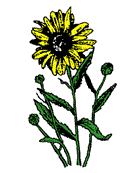Brigid's Hearth Spring!
Springtime! We creep from our caves of hibernation, hungry with the desire to shed winter and embrace spring - movement, life, warmth, color! The sluggish blood stirs in us again as our bodies prepare for a change of season. And like the sap stirring in the trees and plants, we feel within us the movement of life renewing itself. Earth awakens, new life bursts forth! Out with the old! In with the new! The dance of life performed by the Green Man and the Green Lady is happening inside of us as well as outside of us. Physically and mentally this is a time for creative renewal. Celebrate spring this year by feasting on the fresh new green growing things (and sometimes their roots as well). Nature's wisdom provides for us exactly what our bodies and spirits need at this time of year. These springtime treasures stimulate liver activity, assist digestion and provide a multitude of vitamins and minerals to aid us in our creative renewal. So indulge in some fresh dandelion greens. Or how about some sorrel soup, or watercress pesto? Perhaps some nettle tea or a wild greens salad would suit you better? Go searching for these wild things, or any other seasonal, nutritious/delicious green thing Mother offers to us at this time. Dandelions: (Taraxacum officinale) are easy to find almost anywhere, as those who try to keep a tidy lawn will attest. Instead of mowing them down, why not try eating them instead? The leaves (sweet when young, more bitter when mature) are rich in iron, potassium, calcium, Vitamins A and C. The root can be made into a tea which is helpful in lowering blood pressure and is cleansing to the liver, gall bladder, kidneys, bladder, spleen and pancreas. So shred some of the young leaves into your salad (toss in some of the flowers too); or boil up a pot of them and toss with salt and vinegar. Try a cream of spinach soup recipe with dandelion greens in place of the spinach. Stinging nettle: (Urtica dioica) is hard to harvest but well worth the effort. Approach stinging nettle with respect and love (and preferably with gloves!) and she will reward you with her many gifts. Nettles are high in chlorophyll, Vitamin A and Vitamin C. It is helpful in cases of low energy, as well as for eczema and other skin conditions. Taken as a warm tea nettle assists lungs, thus is helpful in asthma and other lung conditions. The "sting" of Stinging Nettle disappears when it is cooked or made into a tea, so enjoy it as a cooked green at dinnertime (cream of nettle soup is wonderfully delicious!), or as a nourishing tea anytime. Among Nettle's many virtues are it's wonderful health bestowing benefits on the hair when used as rinse. I've used it for years to keep my hair soft, thick and lustrous. Prepare a strong and hot infusion of Nettle, add a torn up sheet of nori seaweed to it, and allow to infuse for at least 6 hours. Add a tablespoon or so of vinegar to this, strain and pour it into squirt-bottles. Keep one handy in the shower, and store the rest in the fridge, where they will last for several months. The vinegar acts as a preservative and a PH balancer for the hair. Watercress: (Nasturtium officinale) is found in running streams. It has a very robust flavor and is a welcome addition to salads. Try it in your favorite pesto recipe by using it in place of 1/2 of the basil. It is high in iron, iodine and Vitamin C; and helpful for those suffering digestive disturbances, anemia, and upper respiratory problems. Avoid prolonged regular use, however (don't use it every day, or for longer than 4 weeks); it could be a bit too much for your kidneys to handle. Sorrel: There are many varieties of sorrel. I have recently been introduced to Sheep Sorrel (Rumex acetellosa) and find it to be one of my favorites. Its sweetly sour taste makes it good to nibble right out there in the garden, but bring it inside and put it in the salad, please. Common garden sorrel (Rumex acetosa) is also good in salads, as well as when steamed as a vegetable. Try it in the pesto, too; or as a chopped green in soup. It is known as a blood purifier, and has been used to treat skin eruptions, fevers and kidney problems that call for a diuretic. As with other herbs high in oxalic acid, avoid prolonged use. Plantain: (Plantago major, Plantago lanceolata) is often as easy to find as Dandelion, being regarded as a common weed. In actuality though, Plantain is highly nutritious. I have used the bruised leaves rubbed on insect stings for quick relief. It has also been used for chronic skin conditions, as well as for menstrual problems, kidney and bladder infections. The seeds, when made into a seed tea by soaking them overnight in water, are helpful in alleviating constipation. These herbs, and many others, are Mother Nature's Spring Tonics. Enjoy them in good health - and let yourself be renewed and re-created!
There are some general rules one should be aware of
Happy Spring and Blessed Be!
Originally published in Dragon's Quest Magazine, Spring Equinox, 1993
|


